Abstract
Carbon capture, utilization, and storage (CCUS) technology is considered an effective way to reduce greenhouse gases, such as carbon dioxide (CO2), which is significant for achieving carbon neutrality. Based on Derwent patent data, this paper explored the technology topics in CCUS patents by using the latent Dirichlet allocation (LDA) topic model to analyze technology’s hot topics and content evolution. Furthermore, the logistic model was used to fit the patent volume of the key CCUS technologies and predict the maturity and development trends of the key CCUS technologies to provide a reference for the future development of CCUS technology. We found that CCUS technology patents are gradually transforming to the application level, with increases in emerging fields, such as computer science. The main R&D institutes in the United States, Europe, Japan, Korea, and other countries are enterprises, while in China they are universities and research institutes. Hydride production, biological carbon sequestration, dynamic monitoring, geological utilization, geological storage, and CO2 mineralization are the six key technologies of CCUS. In addition, technologies such as hydride production, biological carbon sequestration, and dynamic monitoring have good development prospects, such as CCUS being coupled with hydrogen production to regenerate synthetic methane and CCUS being coupled with biomass to build a dynamic monitoring and safety system.
1. Introduction
The emission of greenhouse gases, especially carbon dioxide, aggravated global warming and became a major strategic issue that threatens the sustainable development of humanity [1,2]. CCUS technology is an important method to reduce carbon dioxide and to address global climate change, which is of great significance for achieving the goal of carbon neutrality [3,4]. CCUS technology is a carbon dioxide emission reduction and utilization technology, which separates and captures carbon dioxide from various emission sources or the air and transports it to a suitable site for storage or recycling through chemical or biological conversion [5,6]. In recent years, the development of CCUS technology was given high priority worldwide, and the maturity of related technologies is rapidly increasing, showing the development trends of new technologies emerging and energy costs gradually decreasing. The International Energy Agency (IEA) assessed the emission reduction potential of CCUS, which could reduce 6.9 × 109 t of CO2 per year by 2070 in a sustainable development scenario, accounting for 19.27% of the total emission reduction [7]. The Intergovernmental Panel on Climate Change (IPCC) pointed out that in order to achieve the temperature rise control target of 1.5 °C in 2100, the cumulative global CCUS needs to reduce 5.5 × 1011~1.0 × 1012 t of CO2 [8]. Currently, the knowledge spillover efficiency of CCUS technology is relatively high in the United States, Europe, Japan, Australia, and New Zealand [9]. Although the research on CCUS technology in China started late, positive results were achieved by the strengthening of basic research, key technology research, and project integration and demonstration. However, compared with the aforementioned international frontier, the individual key technologies and commercial integration levels within CCUS are lagging behind [10,11,12].
A CCUS technology system covers several key technologies in the following fields: (1) CO2 capture and transport; (2) CO2 mineralization; (3) reduction and recycling; (4) biological carbon sequestration; (5) carbon geological storage; and (6) CO2 enhanced underground resource exploration [13,14,15,16,17,18]. Previous studies on the evolution of CCUS technology were mostly theoretical analyses, mainly focusing on policies and regulations [19,20], technical routes [21], and life cycle and economic analyses [22]. Some researchers also explored the evolution from a bibliometric perspective [23]. However, only a few studies that analyze the technology evolution process from the perspective of technology topics were based on patent data. In addition, there is a lack of studies that use patent volume to predict the maturity levels and development trends of important CCUS technologies.
The set of words describing the technical details in the patent data text contains the most important information, including the technological innovation. Therefore, based on Derwent patent data, this paper mined the hot technology topics and its heat in CCUS in different years, and thus, a content evolution of CCUS was obtained. The logistic model was applied to fit the patent volume of the key CCUS technologies and predict the levels of the maturity and development trends of the key CCUS technologies. The aim of this paper is to reveal the research status, research focus, and development direction of CCUS technologies and provide the analysis base for the future policies of CCUS technologies.
2. Methodology
2.1. LDA Topic Mining
The LDA topic model is widely used in text topic mining. For semi-structured documents, such as patent documents, the LDA model has the advantages of fast mining, complete coverage, and high accuracy rate. Therefore, this paper applied the LDA topic model to mine and analyze the patent text, which helps to identify the topic words implied in the text, analyze technology evolution, and clarify the trend of technology development.
2.1.1. Data Collection and Pre-Processing
The Derwent Innovation Index (DII) integrates the Derwent World Patents Index (WPI) and the Patents Citation Index to provide patent information worldwide. The patent data in this article come from the Derwent database, based on the patent classification system of the Derwent database and previous research [24]. The searched terms are listed as follows: TS = (“CCS” OR “CCUS” OR “carbon capture” OR “carbon utiliz*” OR “carbon storage” OR “carbon circular utiliz*” OR “carbon sequest*” OR “carbon inject*”OR “CO2 capture” OR “CO2 utiliz*” OR “CO2 storage” OR “CO2 circular utiliz*” OR “CO2 sequest*” OR “CO2 inject*“). The search was conducted on 4 January 2023 based on the above search terms. The searched time dimension was selected as from 2003 to 2022, excluding non-related scientific categories, and a total of 175,922 patent documents were obtained. In addition, during these years, China had the largest number of patents in CCUS.
In order to better mine the text, the patent text was pre-processed by the Python program, which mainly includes the following three steps [25,26]: ① extracting words that can characterize technical information, i.e., title, abstract, and keywords; ② removing common patent words, academic words and stop words such as “what”, “why”, “and”, “before”, “use”, and other common conjunctions among the top 100 academic words provided by the University of Nottingham [27]; ③ lemmatization (word form reduction) processing of stop words such as “the”, “an”, “in”, “at”, etc. The different lexical properties in the words were firstly matched by Wordnet packets. Then, the matching words were unified and lemmatized through the WordNet Lemmatizer program package.
Considering the periodicity of technology evolution, a period stage of 5 years was assumed for topic mining evolution analysis. Thus, 2003–2007 was the first stage, 2008–2012 was the second stage, 2013–2017 was the third stage, and 2018–2022 was the fourth stage. The number of patent documents in each stage and the number of patent terms before and after pre-processing are shown in Table 1. For the convenience of presentation, the total patent data from 2003 to 2022 are expressed as “total text sets”, and the patent data of each stage are expressed as “stage *”.

Table 1.
Number of CCUS technology patents and vocabulary by stage, 2003–2022.
2.1.2. Parameter Setting
The hyperparameters α and β are the parameters that determine the distribution of topics and words in a document when performing LDA topic mining, respectively. Referring to the relevant study [28], as well as considering the refinement of the topics, the processing speed, and the availability of the results, the parameters α = 0.5 and β = 0.1 were chosen in this paper. The parameter K (optimal number of topics) determines the final number of topics extracted by the LDA model [29]. Perplexity is a widely used method to determine the optimal number of topics. It can be calculated as follows:
where Dtest represents the entire text set; D represents the number of documents in the text set; wd represents the sequence of words in the d document; the non-repetitive vocabulary of the d document is denoted by Nd; p(wd) is the probability of the word sequence wd, calculated by multiplying the probabilities of all words in the d document; the i-th word in document d is noted as i; K represents the assumed number of topics; p(zk|d) represents the probability of matching topic K in a given document; and p(wi|zk) represents the probability that topic zk contains word i.
The optimal number of topics in each stage of the text sets and the total text sets were obtained by Equation (1) and Equation (2), respectively, as shown in Table 2.

Table 2.
Optimal number of topics in the text sets at each time stage.
2.1.3. Topic Mining
The iterative calculation was performed by setting the steps of iterations as 500 according to the above parameters. Output results topic distribution matrix θD×K showed the probability distribution of the K topic in the total text sets, representing the degree of topic contribution to the whole text, as shown in Equation (3).
Each row in the matrix corresponds to a document, and θij presents the probability that the i document belongs to topic j.
2.2. LDA Topic Evolution
2.2.1. Topic Heat Evolution
From the viewpoint of patent topic text, topic heat means the probability of a certain type of patent topic appearing in a fixed period, and a higher probability means a higher topic heat. Therefore, analyzing the changes of topic heat as time could be better for observing the development of the related patents. It can be calculated as
where Q(Zt,k) denotes the intensity of topic k in the current time slice t, θd,k presents the probability of the topic k in the d document, and Dt indicates the number of documents on time slice t.
2.2.2. Topic Content Evolution
The degree of information similarity between CCUS technical topics was confirmed by calculating the similarity of topics between two close stages with the following formula:
where sim(Di,Dj) represents the similarity between the two different topics of Di and Dj, w is the topic vector in the text, H is the topic vector similarity value, and T denotes the topic vector value of term frequency–inverse document frequency (TF–IDF). If the similarity of topics between two stages is sim > 0.7, then it is claimed that there is an evolutionary relationship between these two topics.
2.3. Technology Maturity Prediction
Logistic models, also known as the sigmoid curves (S-curves), are widely used to analyze and predict the life cycle of the technology maturity. The corresponding development stage of the life cycle is shown in Figure 1. The general formula for the logistic model can be written as
where Nt is the patent data amount, t is the growth time of the corresponding technology from 10% to 90% of the maximum number of patents, k is the predicted maximum number of patents (saturation) obtained by fitting the number of patents curve, α represents the slope of the curve, and β is the turning point of the slope of the curve from small–large–small, which is also called the midpoint of the S-curve.
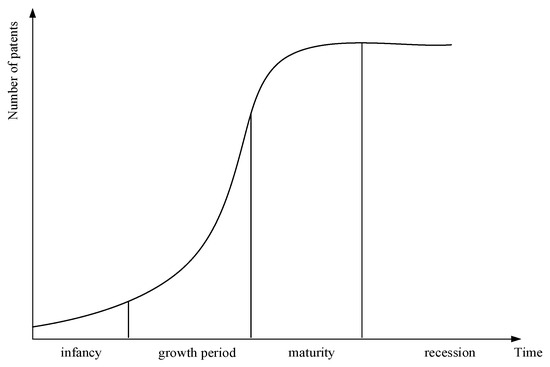
Figure 1.
The development stages of the S-curve life cycle.
3. Analysis of the Current State of Technology Evolution
3.1. LDA Topic Mining
According to Equations (1)–(3), the CCUS patents are mined. The selection of topic words adopts the principles of comprehensiveness and accuracy. The topic mining results named by the comprehensive meaning of each topic feature word by querying the relevant patents are listed in Table 3.

Table 3.
CCUS technology topic mining results.
3.2. Measurement Analysis
3.2.1. Time Distribution
The change in the number of patents over time provides a direct observation of the research trends in CCUS, which gives a macro view of the research development. A 3D bar chart of the changes in the number of CCUS patents is shown in Figure 2.
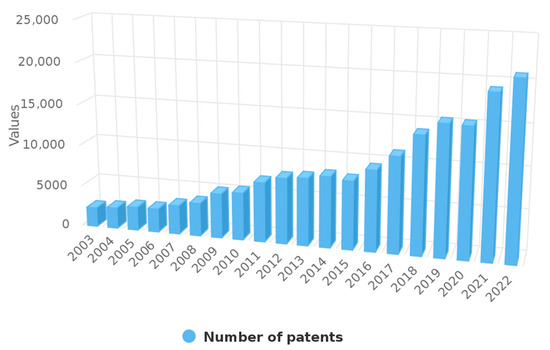
Figure 2.
Changes in the number of CCUS patents over years.
As can be seen from Figure 2, the global CCUS number of patents was maintaining a continuous growth trend. In 2016, the growth of number of patents obviously accelerated due to the signing of the Paris Agreement at the end of 2015. In 2018, the IPCC’s Special Report on Global Warming of 1.5 °C was released, which pointed out the significance of CCUS technology in addressing global climate change [8]. As a result, 2018 became the year with the highest growth rate of CCUS patents. In 2020, due to the sudden outbreak of the coronavirus, field experiments on related technologies were restricted, resulting in a decline in the number of CCUS patents that year. As the situation improved, the number of patents picked up and continued to grow in 2021.
3.2.2. Research Field Distribution
Analyzing the distribution of the research results in different fields can help to show the current research directions in the field. The top 10 fields involved in CCUS were selected by classifying the subject field of the patent text data, and thus, a corresponding radar map of the global CCUS subject field distribution of these top 10 fields was obtained. The radar maps of the top 10 fields in 2003 and 2022 are displayed in Figure 3.
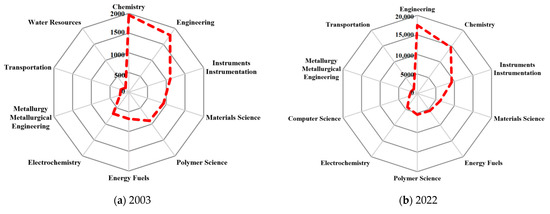
Figure 3.
Global radar map of CCUS subject fields in 2003 and 2022.
In Figure 3, the 2003 and 2022 CCUS patents cover roughly the same fields. In 2003, the number of patent applications in chemistry ranked first and those in engineering ranked second, while the number of patent applications in 2022 in engineering ranked first and those in chemistry ranked second. This indicates that the technology patents of CCUS gradually transformed to the application level. Different from in 2003, in 2022, the field of computer science was newly added to the top 10 and rose to eighth place. This shows that the technologies related to computer science (e.g., sensor, dynamic monitoring) in CCUS patents are developing at a high speed, and more attention is being paid to safety and the economy in the implementation of CCUS technologies.
In summary, the core technologies of CCUS are concentrated in the fields of engineering, chemistry, and instruments instrumentation. At the same time, it is also important to focus on emerging areas, such as computer science, and strengthen the development of these areas, which would have a propulsive effect on CCUS technology.
3.2.3. Comparison of International R&D Institutes
Among the top 100 R&D institutions with CCUS technology patent applications from 2003 to 2022, China accounted for the highest proportion (52%), followed by Japan (16%), the United States (15%), Korea (7%), Germany (6%), France (5%), and Saudi Arabia (2%). The statistics on the top 15 innovative entities in CCUS patent applications and the number of patents in the US, Europe, Japan, Korea, and China are shown in Table 4.

Table 4.
Top 15 patent entities and their patent numbers in CCUS patent applications in China and in US, Europe, Japan, and Korea.
As can be seen from Table 4, there are certain differences in the institutes of authorization between China and the US, Europe, Japan, and Korea. By 2022, the top 15 innovation entities with the highest number of patent applications in the US, Europe, Japan, and Korea are all listed companies. Among the top 15 innovation entities in China, only 4 are listed companies, and the others are universities and university-affiliated research institutes.
In the US, Europe, Japan, and Korea, CCUS technology R&D is more in line with market demand after market research, so CCUS technology can be better applied and commercialized, which promotes the continuous development of the CCUS industry. At the same time, the patent institutes of the US, Europe, Japan, and Korea are larger in scale, and the products derived from core technology occupy a higher share of the international market with a stronger competitiveness. In China, universities occupy a large proportion of the CCUS patent authorization market. The orientation of universities themselves is education and scientific research, which deviates from the purpose of enterprises pursuing market interests through innovation. From this perspective, China’s CCUS development is not as close to the market as that of the US, Europe, Japan, and Korea. While using universities to strengthen basic research, China should promote industrial development and break through technological blockades.
3.3. CCUS Technology Topic Heat Evolution Analysis
Based on the topic mining results of the CCUS total text sets, the intensity values of each topic in different years are calculated according to Equation (4). A topic evolution river diagram is drawn as time according to the change trend, as shown in Figure 4, where Ti represents the i topic, and i = 1,2,3,…,23.
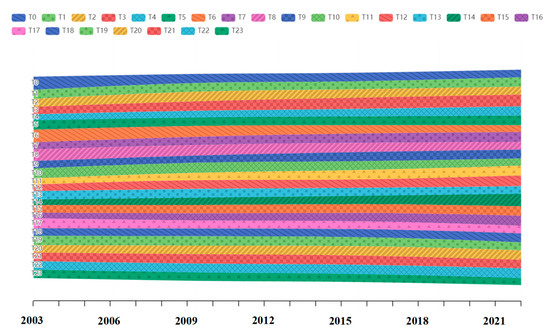
Figure 4.
River map of the evolution of CCUS patent topic heat.
In the river map, the wider the width of a certain river is, the greater the intensity of the corresponding topic is. This can be seen from the CCUS patent topic evolution river map. Pipelines (T0), electricity (T6), coal (T8), alarm systems (T10), sensors (T17), adsorbents (T19), and microalgae (T23) are the basic technologies for the pre-development of CCUS. Their heat tends to decrease over time. Two reasons cause this situation. On the one hand, as the corresponding technology reaches maturity, the heat naturally decreases. On the other hand, some of the basic technologies evolve into new technologies.
Biological carbon sequestration (T3), CO2-EOR (T4), geological storage (T7), anti-corrosion technology (T9), CO2 mineralization (T11), dynamic monitoring (T12), hydride production (T14), economy (T15), geological utilization (T16), synthesis of organic chemicals (T18), CO2 separation technology (T20), and bioenergy (T22) are the key technologies for the current development of CCUS. The heat of these aforementioned technologies is increasing over time. Most of them are CO2 utilization and storage technologies, while CO2 capture technologies are less hot. Hydride production (T14), biological carbon sequestration (T3), dynamic monitoring (T12), geological utilization (T16), geological storage (T7), and CO2 mineralization (T11) are also key technologies with a relatively high heat.
The evolution of oxygen-enriched combustion (T1) and fuel synthesis and preparation (T5) are two topics that could be classified as having three phases. The heat of these two topics was relatively high in the first stage, and then it decreased in the second and third stages because the related technologies were at a bottleneck. In the fourth stage, due to a breakthrough in technological bottlenecks, such as oxy-fuel combustion costs and energy intensity, the heat of these topics gradually increased. Regarding CO2 adsorption (T2), water utilization (T13), and reservoirs (T21), the heat of these three topics was upward-declining, which indicates that a certain technical bottleneck was broken in the first stage, and then the technologies tended to mature and evolve to higher-level technologies.
3.4. Analysis of the Evolution of Technical Subject Matter Content in CCUS
In accordance with the topic correlation mentioned above, the similarity of the topics at each stage, as calculated by Equation (5), was presented in the form of a Sankey diagram. For the purpose of differentiation, the topics from the first stage to the fourth stage are labeled “A, B, C and D”, as shown in Figure 5.
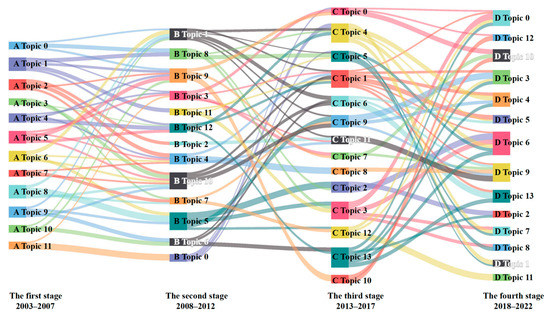
Figure 5.
CCUS patent topic evolution river diagram.
With the development of global carbon neutrality, countries made large-scale innovations in the field of CCUS technology, evolving from the basic technical level to the application level. The focus of R&D changed over time. At present, CCUS technologies are beginning to be applied and commercialized, with more emphasis placed on breaking energy technology bottlenecks and reducing costs, such as CO2-EOR, biological carbon sequestration, CO2 mineralization, and other application-oriented technologies.
The basic CCUS technologies, such as pipelines, sensors, microalgae, electricity, coal, and adsorbents were developed well at the beginning. However, with continuous improvement and subsequent maturity, technologies are gradually transforming into geological storage, dynamic monitoring, bioenergy, geological utilization, and CO2 separation technology.
The related topic heat for carbon dioxide capture technology shows a decreasing trend. In contrast, the technologies of carbon dioxide storage and utilization technology and CCUS management are on the rise. The key areas of CO2 storage and utilization technologies mainly are bio-utilization (e.g., bioenergy and biological carbon sequestration), geological utilization (e.g., CO2-EOR/EGR), chemical utilization (e.g., hydride production, etc.), and geological storage (e.g., aquifers or oil and gas formations). In addition, the key area of CCUS management technology is mainly dynamic monitoring.
4. Predictive Analysis of Key Technologies’ Evolution in CCUS
Six technologies with the highest heat are selected for analysis in this section. They are hydride production (T14), biological carbon sequestration (T3), dynamic monitoring (T12), geological utilization (T16), geological storage (T7), and CO2 mineralization (T11). The number of patents of each technology from 2003 to 2022 was searched by using the Derwent Innovation Index (DII), as shown in Figure 6.
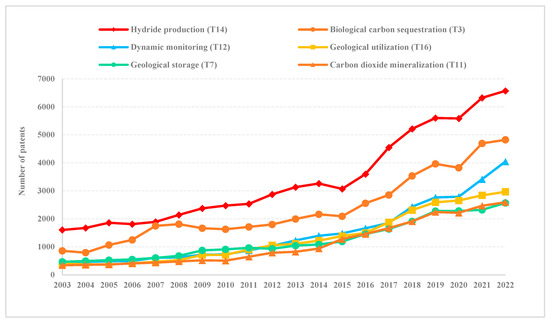
Figure 6.
Number of patents for key CCUS technologies from 2003 to 2022.
From Figure 6, it can be seen that the number of patents for the selected six key technologies of CCUS grew significantly from 2003 to 2022, even though the number of patents grew relatively slowly between 2003 and 2015. The rate of growth greatly accelerated in 2016 after the Paris Agreement was signed at the end of 2015. From the perspective of the number of patents for each key technology, the number of patents of hydride production (T14) and biological carbon sequestration (T3) was relatively high, and the growth rate remained unabated since 2020. With respect to the topics of dynamic monitoring (T12), geological utilization (T16), geological storage (T7), and CO2 mineralization (T11), the number of patents is approximate. However, the growth rate of dynamic monitoring (T12) is explosive after 2020, due to the development of computer science and the improvement of safety and economic production awareness.
Based on the logistic model, the number of patents for Topic 14, Topic 3, Topic 12, Topic 16, Topic 7, and Topic 11 from 2003 to 2022 were fitted by Origin software, and thus, the corresponding field logistic curve fitting plots and topic fitting statistical parameters were obtained. Figure 7a–f represent the fitted curves of six selected key CCUS technologies for the number of patents. The curves before 2022 represent the existing number of patents, and the curves after 2022 represent the forecasted number of patents.
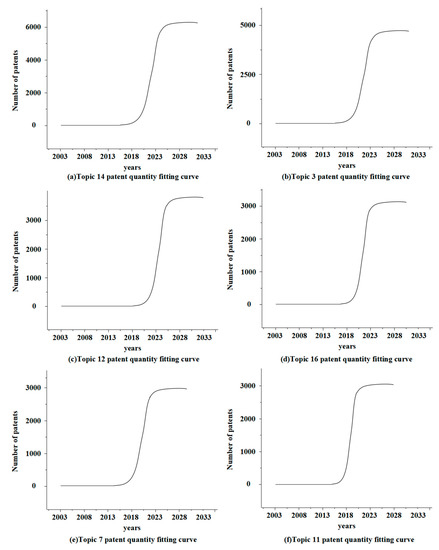
Figure 7.
Fitted curve of six key CCUS technologies based on the number of patents.
The degree of freedom of the fitting curve statistics was set as 22. The adjusted values of R2 were 0.99184, 0.99615, 0.99827, 0.99652, 0.98949, and 0.99549, which indicates that the individual topic curves fit the number of patents well. Based on Figure 7, the development stages of the key CCUS technologies were determined, and the results are shown in Table 5. The infancy period of the six key CCUS technologies lasted for a long time, and the development speed increased slowly. Around 2016, various technologies entered the growth stage, and the number of patents for related technologies began to increase significantly. After the growth period, related technologies enter the forecasted mature period. At this stage, the technology accumulation is sufficient, and part of the research starts to be transformed into application. Therefore, the growth rate of the number of patents is relatively slow at this stage, even though it is still growing. Compared with the other three technologies, the maturity periods for the topics of hydride production (T14), biological carbon sequestration (T3), and biological carbon sequestration (T3) come late, so the related topics should be the key technologies for future development. Just as CCUS is coupled with hydrogen production to regenerate synthetic methane, CCUS is coupled with biomass to build a dynamic monitoring and safety system. After the maturity period, the number of relevant patents reaches saturation, which is caused by the wide use in commerce. Then, the development of the matured technology faces three possibilities. One possibility is that the heat of technology research begins to decline, and the related technology is washed. Another possibility is that the related technology is replaced by new technology, while the third possibility is that some patented technology fails to be commercialized.

Table 5.
Development stages of key CCUS technologies.
5. Conclusions
Firstly, in this paper, we captured a total of 175,922 patents related to CCUS technology from 2003 to 2022 by using Derwent patent data. Secondly, the LDA topic model was used to mine the technical topics of the CCUS patents. Then, the evolution of global CCUS technology was analyzed from three aspects: measurement analysis, technical topic heat, and technical topic content evolution. Finally, the logistic model was applied to fit the patent volume of the key CCUS technologies and predict the degrees of maturity freedom and development trends of the key CCUS technologies. The specific conclusions are as follows:
(1) Due to the signing of the Paris Agreement, the outbreak node of CCUS technology patents was in 2016. In the key fields of research, CCUS technology patents are gradually transformed to the application level, while the emerging fields, such as computer science are on the rise. Regarding the main R&D institutes, the US, Europe, Japan, and South Korea are led by enterprises, while China is dominated by universities and research institutes. Although the total numbers of patents and R&D institutes in China are the highest in the world, there is still a long way for CCUS technologies to go in China to be applied and commercialized.
(2) The transformation of CCUS technologies can be summarized in two steps. Firstly, CCUS technologies gradually transform from the basic level of pipelines, electricity, coal, and sensors to the technical level, such as CO2 adsorption, water utilization, and reservoirs. Then, hydride production, biological carbon sequestration, CO2-EOR, and CO2 mineralization transform to the application level.
(3) The trend of the topic related to carbon capture technology is declining. The trends of technologies for carbon dioxide storage and utilization technology and CCUS management technology are on the rise. The topics of hydride production, biological carbon sequestration, dynamic monitoring, geological utilization, geological storage, and CO2 mineralization are relatively hot, and the related technologies are the key technologies of CCUS.
(4) The key technologies, such as geological utilization, geological storage, and CO2 mineralization are matured. New technologies would merge to drive the development of CCUS in the aforementioned fields. Technologies such as hydride production, biological carbon sequestration, and dynamic monitoring are in the growth period, each with a bright development prospect. Just as CCUS is coupled with hydrogen production to regenerate synthetic methane, CCUS is coupled with biomass to build a dynamic monitoring safety system.
Author Contributions
Conceptualization, Z.H.; investigation, Y.F. and J.L.; methodology, J.L. and T.S.; supervision, Z.H.; data curation, L.H. and T.S.; writing—original draft, L.H. and Y.F.; writing—review and editing, Z.H. and J.L. All authors have read and agreed to the published version of the manuscript.
Funding
The Henan Institute for Chinese Development Strategy of Engineering & Technology (Grant No. 2022HENZDA02), the Science & Technology Department of Sichuan Province Project (Grant No. 2021YFH0010), and the Soft Science Major Project of Henan Province (Grant No. 212400410002).
Data Availability Statement
Data are available in a publicly accessible repository.
Conflicts of Interest
The authors declare no conflict of interest.
References
- Liu, J.; Shi, T.; Huang, L. A Study on the Impact of Industrial Restructuring on Carbon Dioxide Emissions and Scenario Simulation in the Yellow River Basin. Water 2022, 14, 3833. [Google Scholar] [CrossRef]
- Jorgenson, A.K.; Fiske, S.; Hubacek, K.; Li, J.; McGovern, T.; Rick, T.; Schor, J.B.; Solecki, W.; York, R.; Zycherman, A. Social science perspectives on drivers of and responses to global climate change. Wiley Interdiscip. Rev. Clim. Chang. 2019, 10, e554. [Google Scholar] [CrossRef]
- Xie, Y.; Hou, Z.; Liu, H.; Cao, C.; Qi, J. The sustainability assessment of CO2 capture, utilization and storage (CCUS) and the conversion of cropland to forestland program (CCFP) in the Water–Energy–Food (WEF) framework towards China’s carbon neutrality by 2060. Environ. Earth Sci. 2021, 80, 468. [Google Scholar] [CrossRef]
- Ali, S.A.; Mulk, W.U.; Ullah, Z.; Khan, H.; Zahid, A.; Shah, M.U.H.; Shah, S.N. Recent Advances in the Synthesis, Application and Economic Feasibility of Ionic Liquids and Deep Eutectic Solvents for CO2 Capture: A Review. Energies 2021, 15, 9098. [Google Scholar] [CrossRef]
- IEA. About CCUS. Available online: https://www.iea.org/reports/about-ccus (accessed on 5 January 2023).
- Hou, Z.; Luo, J.; Xie, Y.; Wu, L.; Huang, L.; Xiong, Y. Carbon Circular Utilization and Partially Geological Sequestration: Potentialities, Challenges, and Trends. Energies 2023, 16, 324. [Google Scholar] [CrossRef]
- IEA. Energy Technology Perspectives 2020. Available online: https://www.iea.org/reports/energy-technology-perspectives-2020 (accessed on 5 January 2023).
- IPCC. Global Warming of 1.5 °C. Available online: https://www.ipcc.ch/sr15/ (accessed on 5 January 2023).
- Bae, J.; Chung, Y.; Lee, J.; Seo, H. Knowledge spillover efficiency of carbon capture, utilization, and storage technology: A comparison among countries. J. Clean. Prod. 2020, 246, 119003. [Google Scholar] [CrossRef]
- Sun, L.; Dou, H.; Li, Z.; Hu, Y.; Hao, X. Assessment of CO2 storage potential and carbon capture, utilization and storage prospect in China. J. Energy Inst. 2018, 91, 970–977. [Google Scholar] [CrossRef]
- Zhang, X.; Li, Y.; Ma, J.; Liu, L. Development of Carbon Capture, Utilization and Storage Technology in China. Strateg. Study CAE 2021, 23, 70–80. [Google Scholar] [CrossRef]
- You, K.; Yu, Y.; Cai, W.; Liu, Z. The change in temporal trend and spatial distribution of CO2 emissions of China’s public and commercial buildings. Build. Environ. 2023, 229, 109956. [Google Scholar] [CrossRef]
- Hills, C.D.; Tripathi, N.; Carey, P.J. Mineralization technology for carbon capture, utilization, and storage. Front. Energy Res. 2020, 8, 142. [Google Scholar] [CrossRef]
- Xiong, Y.; Hou, Z.; Xie, H.; Zhao, J.; Tan, X.; Luo, J. Microbial-mediated CO2 methanation and renewable natural gas storage in depleted petroleum reservoirs: A review of biogeochemical mechanism and perspective. Gondwana Res. 2022; in press. [Google Scholar] [CrossRef]
- Luo, J.; Hou, Z.; Feng, G.; Liao, J.; Haris, M.; Xiong, Y. Effect of Reservoir Heterogeneity on CO2 Flooding in Tight Oil Reservoirs. Energies 2022, 15, 3015. [Google Scholar] [CrossRef]
- Nocito, F.; Dibenedetto, A. Atmospheric CO2 mitigation technologies: Carbon capture utilization and storage. Curr. Opin. Green Sustain. Chem. 2020, 21, 34–43. [Google Scholar] [CrossRef]
- Ahmed, D.S.; El-Hiti, G.A.; Yousif, E.; Ali, A.A.; Hameed, A.S. Design and synthesis of porous polymeric materials and their applications in gas capture and storage: A review. J. Polym. Res. 2018, 25, 1–21. [Google Scholar] [CrossRef]
- Ali, S.A.; Shah, S.N.; Shah, M.U.H.; Younas, M. Synthesis and performance evaluation of copper and magnesium-based metal organic framework supported ionic liquid membrane for CO2/N2 separation. Chemosphere 2023, 311, 136913. [Google Scholar] [CrossRef]
- Jiang, K.; Ashworth, P.; Zhang, S.; Liang, X.; Sun, Y.; Angus, D. China’s carbon capture, utilization and storage (CCUS) policy: A critical review. Renew. Sustain. Energy Rev. 2020, 119, 109601. [Google Scholar] [CrossRef]
- Zhang, H. Regulations for carbon capture, utilization and storage: Comparative analysis of development in Europe, China and the Middle East. Resour. Conserv. Recycl. 2021, 173, 105722. [Google Scholar] [CrossRef]
- Zhang, X.; Fan, J.L.; Wei, Y.M. Technology roadmap study on carbon capture, utilization and storage in China. Energy Policy 2013, 59, 536–550. [Google Scholar] [CrossRef]
- Zhang, Z.; Wang, T.; Blunt, M.J.; Anthony, E.J.; Park, A.H.A.; Hughes, R.W.; Webley, P.A.; Yan, J. Advances in carbon capture, utilization and storage. Appl. Energy 2020, 278, 115627. [Google Scholar] [CrossRef]
- Jiang, K.; Ashworth, P. The development of Carbon Capture Utilization and Storage (CCUS) research in China: A bibliometric perspective. Renew. Sustain. Energy Rev. 2021, 138, 110521. [Google Scholar] [CrossRef]
- Pires, E.A.; Ribeiro, N.M.; Quintella, C.M. Sistemas de Busca de Patentes: Análise comparativa entre Espacenet, Patentscope, Google Patents, Lens, Derwent Innovation Index e Orbit Intelligence. Cad. De Prospecção 2020, 13, 13. [Google Scholar] [CrossRef]
- Qi, Y.; Peng, W.; Xiong, N.N. The effects of fiscal and tax incentives on regional innovation capability: Text extraction based on python. Mathematics 2020, 8, 1193. [Google Scholar] [CrossRef]
- Setchi, R.; Spasić, I.; Morgan, J.; Harrison, C.; Corken, R. Artificial intelligence for patent prior art searching. World Pat. Inf. 2021, 64, 102021. [Google Scholar] [CrossRef]
- AcademicVocabulary. Available online: http://www.nottingham.ac.uk/alzsh3/acvocab/wordlists.htm (accessed on 12 January 2023).
- Jelodar, H.; Wang, Y.; Yuan, C.; Feng, X.; Jiang, X.; Li, Y.; Zhao, L. Latent Dirichlet allocation (LDA) and topic modeling: Models, applications, a survey. Multimed. Tools Appl. 2019, 78, 15169–15211. [Google Scholar] [CrossRef]
- Sbalchiero, S.; Eder, M. Topic modeling, long texts and the best number of topics. Some Problems and solutions. Qual. Quant. 2020, 54, 1095–1108. [Google Scholar] [CrossRef]
Disclaimer/Publisher’s Note: The statements, opinions and data contained in all publications are solely those of the individual author(s) and contributor(s) and not of MDPI and/or the editor(s). MDPI and/or the editor(s) disclaim responsibility for any injury to people or property resulting from any ideas, methods, instructions or products referred to in the content. |
© 2023 by the authors. Licensee MDPI, Basel, Switzerland. This article is an open access article distributed under the terms and conditions of the Creative Commons Attribution (CC BY) license (https://creativecommons.org/licenses/by/4.0/).